Question 1.
Divide the given shapes as instructed.
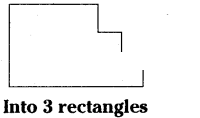
Solution:
Rectangle ABCD
Rectangle CEFG
Rectangle FHIJ
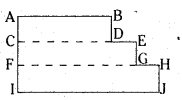
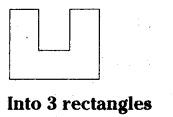
Solution:
Rectangle ABCD
Rectangle EFGH
Rectangle CHIJ

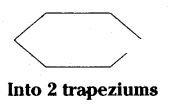
Solution:
Trapezium ABEF Trapezium BCDE
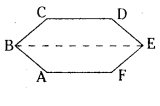
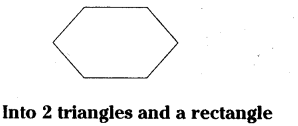
Solution:
Triangle ABC
Triangle DEF B
Rectangle ACDF
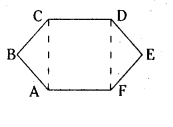
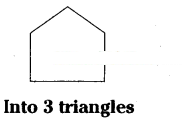
Solution:
Triangle BCD
Triangle BDE
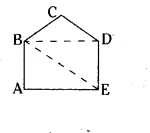
Question 2.
Find the area enclosed by each of the following figures
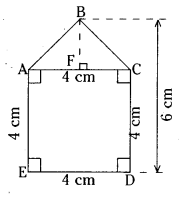
Solution:
i) Area of a pentagon ABCDE = Area of square ACDE + area of ΔABC
= AE × ED + 1/2 AC × BF
= 4 × 4 + 12 × 4 × 2
[∵ AC = ED = 4 cm;
BF = BD-CD = 6-4 = 2 cm]
= 16 + 4 = 20 sq.cm.
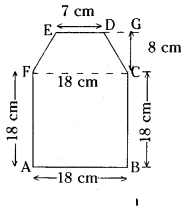
Area of a figure ABCDEF
= Area of square ABCF + area of trapezium CDEF
= AB × BC + 1/2 CG × (ED + CF)
= 18 × 18 + 1/2 × 8 × (7+ 18)
[∵h = CG = 8 cm, FC = AB = 18 cm]
= 324 + 4 × 25
= 324 + 100
= 424 cm2
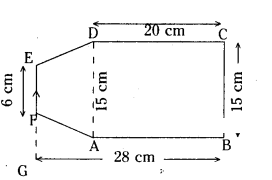
Area of a figure ABCDEF
= Area of rectangle ABCD + area of trapezium ADEF
= AB × BC + 1/2 × GA × (EF + AD)
= 20 × 15 + 1/2 × 8 × (6 + 15)
[∵ GA = GB-AB = 28-20 = 8cm;
AD = BC - 15 cm]
= 300 + 4 × 21
= 300 + 84
= 384 sq.cm
Question 3.
Calculate the area of a quadrilateral ABCD when length of the diagonal AC = 10 cm and the lengths of perpendiculars from B and D on AC be 5 cm and 6 cm respectively.
Solution:
From the figire given below
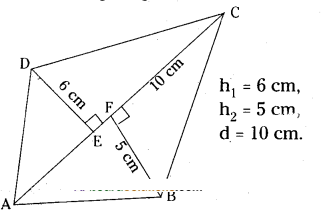
h1= 6 cm,
h2= 5 cm,
d = 10 cm.
Area of a quadrilateral ABCD
=1/2 d(h1+h2) . .
=1/2 AC × (DE + BF)
=1/2 × 10(6+5)
= 5 × 11 = 55sq.cm.
Question 4.
Diagram of the adjacent picture frame has outer dimensions 28 cm × 24 cm and inner dimensions 20 cm × 16 cm. Find the area of shaded part of frame, if width of each section is E the same.
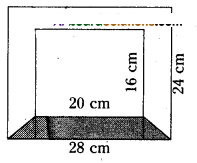
Solution:
The outer dimensions of a picture frame = 28 cm × 24 cm
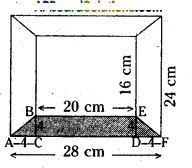
Length of the outer edge = 28 cm.
Breadth of the outer edge = 24 cm.
Dimensions of inner picture frame = 20 cm × 16 cm
Length of inner edge = 20 cm
Breadth of inner edge = 16 cm.
Area of AABC = 1/2 × b × h
=1/2 × AC × BC
=1/2 × 4 × 4 = 8 cm2
Area of rectangle CDEB = l × b
= CD × DE
= 20 × 4
= 80 cm2
Area of ADEF = 1/2 × b × h
=1/2 × DF × DE
=1/2 × 4 = 8sq.cm
∴ The area of the shaded region
= ar ΔABC + ar ▭ CDEB + ar ADEF
= 8 + 80 + 8
= 96 sq.cm.
Question 5.
Find the area of each of the following fields. All dimensions are in metres
Solution:
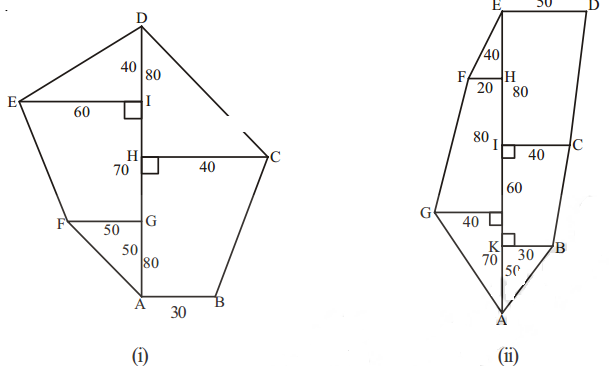
(i) Area of a trapezium ABCH
=1/2 × h(a + b)
=1/2 × 80 × (30 + 40)
= 40 (70)
= 2800 sq.m.
Area of ΔHCD = 1/2 × HC × HD
= 1/2 × 40 × 80
= 1600 sq.m.
Area of ΔEID = 1/2 × El × ID
=1/2 × 60 × 40
= 1200 sq.m.
Area of trapezium FGIE
= 1/2 × h(a + b)
= 1/2 × 70 × (50 + 60)
= 35 (110)
= 3850 sq.m.
Area of ΔFGA = 1/2 × FG × GA
= 1/2 × 25 × 50
= 1250 sq.m.
∴ Area of the field

= 2800 + 1600 + 1200 + 3850 + 1250
= 10700 sq.m.
ii) Area of ΔABK = 1/2 × KB × KA
= 1/2 x 30 × 50
= 750 sq.m.
Area of trapezium KBCI
=1/2 × h(a + b)
=1/2 × 60 (30 + 40)
= 30 (70)
= 2100 sq.m.
Area of trapezium ICDE
=1/2 × h(a + b)
=1/2 × 80 × (40 + 50)
= 40 (90)
= 3600 sq.m.
Area of ΔFHE = 1/2 × FH × HE
=1/2 × 20 × 40
= 400 sq.m.
Area of trapezium GJHF
= 1/2 × h(a + b)
= 1/2 × 80 × (40 + 20)
= 40 (60)
= 2400 sq.m.
∴ Area of ΔGJA = 1/2 × GJ × JA
= 1/2 × 40 × 70
= 1400 sq.m.
∴ Area of the field

= 750 + 2100 + 3600 + 400 + 2400 + 1400
= 10650 sq.m.
Question 6.
The ratio of the length of the parallel sides of a trapezium is 5:3 and the distance between them is 16cm. If the area of the trapezium is 960 cm2, find the length of the parallel sides.
Solution:
The ratio of the length of parallel sides of a trapezium = 5:3.
Let the parallel sides be 5x, 3x say.
∴ a = 5x cm, b = 3x cm
The distance between the parallel sides
(h) = 16 cm.
∴ Area of a trapezium
=1/2 × h(a + b)
=1/2 × 16 x (5x + 3x)
= 8(8x)
= 64 x
According to the problem,
Area of the trapezium = 960 sq.cm.
∴ 64x = 960
x = 960/64 = 15
∴ The length of parallel sides
a = 5x = 5 × 15 = 75 cm
b = 3x = 3 × 15 = 45 cm
Question 7.
The floor of a building consists of around 3000 tiles which are rhombus shaped and each of its diagonals are 45 cm and 30 cm in length. Find the total cost of flooring if each tile costs rupees 20 per m2.
Solution:
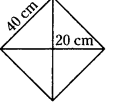
The floor of a building is paved with 3000 tiles.
The shape of each tile is a rhombus.
Diagonals of a tile are
d1= 45 cm, d2= 30 cm.
Area of each tile = 1/2 × d1 × d2
= 1/2 × 45 × 30
= 675 sq.cm.
∴ Area of floor
= 3000 × 675
= 2025000 sq.cm
= 2025000/10000 sq m
(∵ 1 sq.m. = 10000 sq.cm) 2025
=2025/10 sq.m.
= 202.5 sq.m.
The cost of tile per square meter = ₹ 20
∴ The cost of flooring = ₹ 202.5 × 20
= ₹ 4050
Question 8.
There is a pentagonal shaped parts as shown in figure. For finding its area Jyothi and Rashida divided it in two different ways. Find the area in both ways and what do you observe?
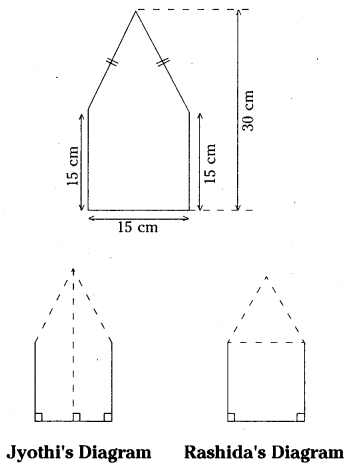
Solution:
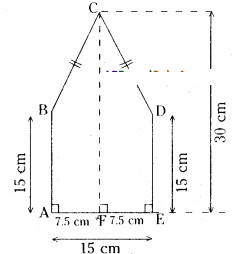
Area of pentagon ABCDE

= 1/2 × AF × (AB + CF) + 1/2 FE x (ED + CF)
= 1/2 × 7.5 × (15+30) + 1/2 x 7.5 x (15+30)
= 1/2 × 7.5 × 45 + 1/2 x 7.5 x 45
= 2 × (12 × 7.5 × 45)
= 7.5 × 45 = 337.50 sq.cm.
Rashida’s Method :
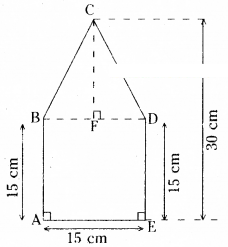
Area of square ABDE = side × side
= AE × ED = 15 × 15 = 225 sq.cm.
Area of ABDC =12 × b × h
= 12 × BD × CF
= 12 × 15 × 15
( ∵ CF = 30 - 15 = 15 )
= 2252 = 112.50 sq.cm
∴ Area of pentagon ABCDE
= ar □ ABDE + ar ΔBDC
= 225 + 112.50 = 337.50 sq.cm
The area of a polygon cant changed if its procedures are changed.
Question 1.
A rectangular acrylic sheet is 36 cm by 25 cm. From it, 56 circular buttons, each of diameter 3.5 cm have been cut out. Find the area of the remaining sheet.
Solution:
The dimensions of a rectangular acrylic sheet = 36 cm × 25 cm.
∴ Its area = l × b
= 36 × 25 = 900 sq.cm
The diameter of a circular button = 3.5 cm
radius = r = d/2 =3.5/2 = 1.75 cm.
∴ Area of each button = πr2
=22/7 × (1.75)2
=22/7 × 1.75 × 1.75
= 9.625 sq.cm.
The area of 56 such buttons = 56 × 9.625 = 539 sq.cm.
∴ The area of remaining sheet
= Area of a rectangular sheet - Area of 56 buttons
= 900 - 539
= 361 sq.cm
Question 2.
Find the area of a circle inscribed in a square of side 28 cm.
[Hint. Diameter of the circle is equal to the side of the square]
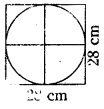
Solution:
Diameter of a circle = d = side of a square = 28 cm.
∴ d = 28 cm
⇒ r = d/2 = 28/2 = 14 cm
∴ Area of a circle = 22/7 × 14 × 14
= 22 × 28
= 616 sq.cm.
Question 3.
Find the area of the shaded region in each of the following figures.
[Hint:d + d/2 + d/2 = 42]
d = 21
∴ side of the square 21 cm
i)
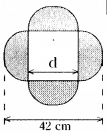
Solution:
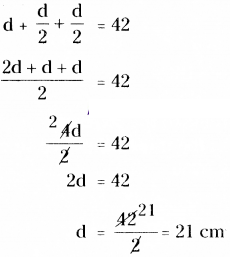
∴ Side of a square, d = 21 cm.
Radius of a semicircle = r = d/2 = 21/2 = 10.5 cm
∴ Area of a semi-circle =πr2/2
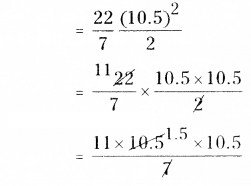
= 11 × 1.5 × 10.5
= 173.250 sq.cm.
∴ Area of 4 shaded semi-circles
= 4 × Area of each semi-circle
= 4 × 173.25 = 693 sq.cm.
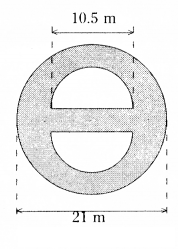
Diameter of a big circle = 21 m

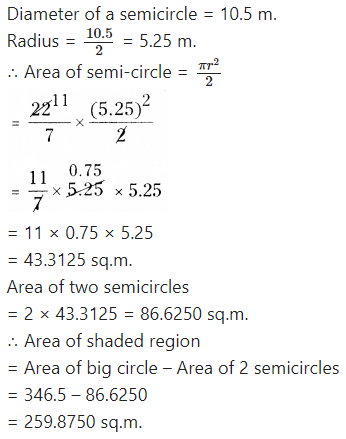
Question 4.
The adjacent figure consists of four small semi-circles of equal radii and two big semi-circles of equal radii (each 42 cm). Find the area of the shaded region
Solution:
Diameter of a bigger semi circle d = 42 cm
Radius, r = 42/2 = 21 cm
Area of a bigger semi circle =πr2/2
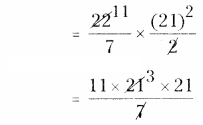
= 11 × 3 × 21
= 693 sq.cm
∴ Area of the shaded region
= Area of two bigger semi circles - Area of two smaller semi circles + Area of two smaller semi circles
= Area of two bigger semi circles
= 2 × Area of bigger semi circles
= 2 × 693 = 1386 sq.cm.
Question 5.
The adjacent figure consists of four half circles and two quarter circles.
If OA=OB=OC=OD= 14cm. Find the area of the shaded region.
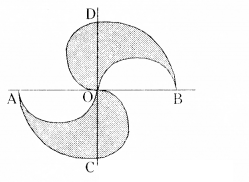
Solution:
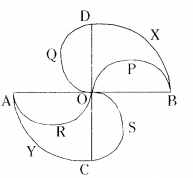
OA = OB = OC = OD = 14CM
Radius of 1/4 of circle BXD, r = 14cm
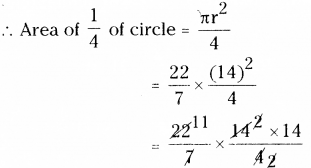
= 154 sq.cm.
∴ Area of the quarter circle AYC
= 154 sq.cm
.’. Area of the shaded region = Area of quarter circle BXD - Area of semi circle OPB + Area of semi circle OQD + Area of quarter circle AYC - Area of semi circle ARO + Area of semi circle OSC
= Area of quarter circle BXD + Area of quarter circle AYC
= 154 + 154
= 308 sq.cm.
Question 6.
In adjacent figure A, B, C and D are centres of equal circles which touch externally is pairs and ABCD is a square of side 7 cm. Find the area of the shaded region.
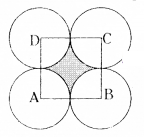
Solution:
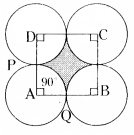
Side of a square,
AB = BC = CD = DA = 7 cm
Area of a square = s × s
= 7 × 7 = 49 sq.cm.
From the above figure,
Radius of a circle, r =Side of a square/2
= 7/2 = 3.5
Areas of 4 equal sectors are equal.
Angle of a sector APQ, x = 90°
Radius, r = 3.5 cm
Area of sector APQ
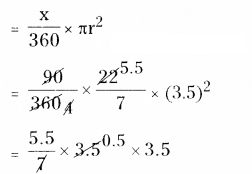
= 5.5 × 0.5 × 3.5
= 9.625 sq.cm.
Total area of 4 equal sectors = 4 × 9.625 = 38.5 sq.cm.
∴ Area of shaded region = Area of square ABCD - Area of 4 equal sectors
= 49 - 38.5
= 10.5 sq.cm.
Question 7.
The area of an equilateral triangle is 49 √ cm2. Taking each angular point as centre, a circle is described with radius equal to half the length of the side of the triangle as shown in the figure. Find the area of the portion in the triangle not included in the circles.
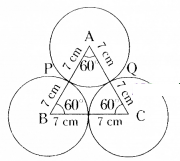
Solution:
From the given figure,
Δ ABC is an equilateral triangle.
∴ Area of an equilateral triangle
= 49 √ 3 sq.em (given)
3 equal circles (whose radii are equal) are touch externally.
Each angle of a sector in the circle = 60°,
Radius r = 7 cm.
∴ The areas of 3 sectors are equal.
∴ Area of a sector APQ
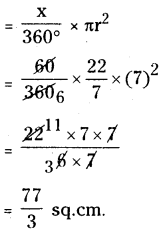
∴ The area of 3 sectors
= 3 × 77/3 = 77 sq. cm
∴ The area of the portion in the triangle not included in the circles
= area of ΔABC - area of 3 equal sectors
=49 √ 3 - 77
=49 × 1.7321 - 77 (∵ √ 3 = 1.7321)
= 84.8729 - 77
= 7.8729 sq.cm.
Question 8.
(i) Four equal circles, each of radius ‘a’ touch one another. Find the area between them.
(ii) Four equal circles are described about the four corners of a square so that each circle
touches two of the others. Find the area of the space enclosed between the circumferences
of the circles, each side of the square measuring 14 cm.
Solution:
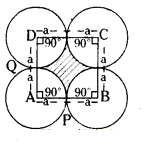
The side of a square ABCD
AB = BC = CD = DA = a + a = 2a units.
∴ Area of a square = s × s
= 2a × 2a = 4a2 sq.units.
4 equal sectors are there.
In each sector,
The angle of a sector APQ, x = 90°
Radius, r = a units
Area of each sector APQ
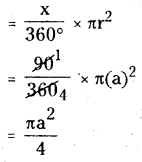
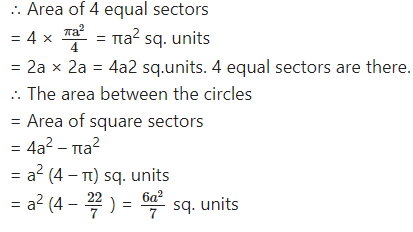
Question 9.
From a piece of cardbord, in the shape ofa trapezium ABCD, and AB||CD and ∠BCD = 90°,= quarter circle is removed. Given AB = BC = 3.5 cm and DE =2 cm. Calcualte the area of the remaining piece of the cardboard. (Take π to be 22/7)
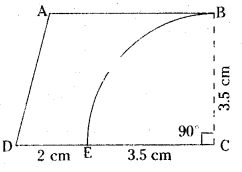
Solution:
ABCD is a trapezium
AB || CD and ZBCD = 90°
AB = BC = 3.5 cm; DE = 2 cm.
Area of a trapezium ABCD :
Length of parallel sides, AB = 3.5 cm
CD = DE + EC
= 2 + 3.5 = 5.5 cm.
Distance between parallel sides,
BC = 3.5 cm.
∴ Area of a trapezium
= 1/2 h (a + b)
= 1/2 × BC (AB + CD)
= 1/2 × 3.5 (3.5 + 5.5)
= 1/2 × 3.5 × 9
= 3.5 × 4.5
= 15.75 sq.cm.
Area of quarter circle EBC :
Radius, r = 3.5 cm
∴ Area of quarter circle
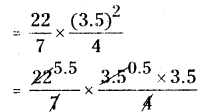
= 5.5 × 0.5 × 3.5
= 9.625 sq.cm.
Area of the remaining piece of card board = Area of a trapezium - 1/2 th of area of a circle
= 15.75 - 9.625
= 6.125 sq.cm.
Question 10.
A horse is placed for grazing inside a rectangular field 70 m by 52 m and is tethered to one corner by a rope 21 m long. How much area can it graze?
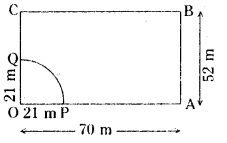
Solution:
From the above figure,
The sector represents the grazing area of a horse.
The angle of a sector OPQ, x = 90°
Radius of a sector OPQ, r = 21 m .
∴ Area of a sector
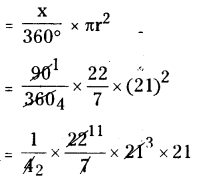
= 346.5 sq.m.
∴ The area of grazing = 346.5 sq.m.